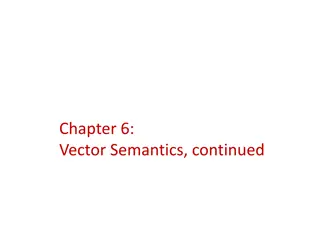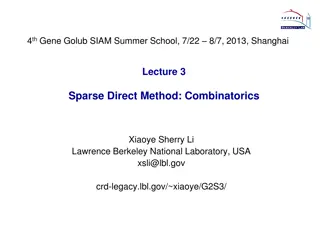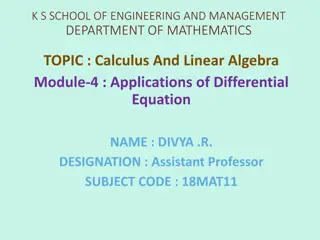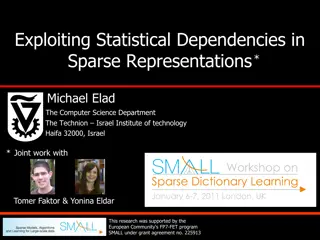
Dynamic Sparse Channel Tracking Using Differential Detection
Explore the innovative approach of utilizing compressive sensing for dynamic sparse channel recovery using differential detection, reducing training overhead while maintaining spectrum efficiency. Learn about various algorithms such as Orthogonal Matching Pursuit (OMP) and the advantages of exploiting temporal correlations in wireless channels.
Download Presentation

Please find below an Image/Link to download the presentation.
The content on the website is provided AS IS for your information and personal use only. It may not be sold, licensed, or shared on other websites without obtaining consent from the author. If you encounter any issues during the download, it is possible that the publisher has removed the file from their server.
You are allowed to download the files provided on this website for personal or commercial use, subject to the condition that they are used lawfully. All files are the property of their respective owners.
The content on the website is provided AS IS for your information and personal use only. It may not be sold, licensed, or shared on other websites without obtaining consent from the author.
E N D
Presentation Transcript
Track A Dynamic Sparse Channel Via Differential Orthogonal Matching Pursuit Presenter: Xudong Zhu Authors: Xudong Zhu, etc. Tsinghua University, Beijing, China
Introduction Channel state information (CSI) Training sequences are usually utilized for channel estimation Overhead of training sequences reduces spectrum efficiency Compressive sensing (CS) CS is able to recover channel from much less measurements CS can be utilized to reduce the length of training sequences Various CS algorithms OMP: Orthogonal matching pursuit CoSaMP: Compressive sampling matching pursuit SOMP: Simultaneous OMP
System Model Dynamic channel recovery ?(?)= ?(?)?(?)+ ?(?),? = 1,2, ,?, ? ?,?2 ?, ,?? ? ?(?)= ?1 denotes the linear measurement; ? ?, 2 ?, , ? ? ?(?)= 1 ?(?)= ? ? ?is a Toeplitz matrix based on ? = ?0,?1, ,?? ?(?) ?? ?,?? denotes the channel vector, ? > ?; ?; 2??.
Dynamic Channel Model Dynamic channel (?)= ?? (?)?? (?),1 ? ?,1 ? ?, ? (?) {0,1} denotes whether there is a non-zero channel tap; (?)denotes the corresponding path gain; (1) Bernouli ?1,1 ? ?; ?= 1|?? (?)= ?? (?) ?? 0,??2. ?? ?? ?? ?0 1= ?{?? ?? ?? ? 1= 0}, ?1 0= ?{?? (?),1 ? ?,1 ? ?; ?= 0|?? ? 1= 1}; (? 1)+ ??
Dynamic Channel Model 1.4 Sparse Channel in Time slot 1 Sparse Channel in Time slot 2 Sparse Channel in Time slot 3 1.2 1 Path gains evolve smoothly over time 0.8 Path Gain 0.6 A disappeared tap in time slot 2 and 3 A burst tap in time slot 3 0.4 0.2 0 0 20 40 60 80 Path Delay 100 120 140 160 180 Fig1. Illustration of the dynamic Vehicular B channel.
Differential Detection Channel recover in former time slot ?(? 1) OMP(?? 1,?) Differential Detection ?(?) D OMP(?? ?? 1,?) Channel recover in current time slot ?(?) ?(?)+ ?(? 1)
Advantages of Differential Detection Exploiting temporal correlations of practical wireless channels Tracking dynamical changing channel Low computational complexity at each time slot ?(?) D OMP(?? ?? 1,?)
Simulation Setting ? = 400,? = 200; ?1= 0.025 ?{?} = ??1= 10; ?1 0= 0.01,?0 1=?1?1 0 1 ?1; ??= 0.05,??= 0.05,? = 1,??= 1; ? = 150; 2 channel taps disappear at ? = 80.
Simulation result (1) 0 10 Linear Method Standard OMP A-SOMP HB-Kalman Proposed S-OMP -1 10 MSE -2 10 -3 10 0 50 100 150 Time Fig2. MSE performance comparison against time slot t.
Simulation result (2) 1 0.9 0.8 Correct Detection Probability 0.7 0.6 0.5 0.4 Hard Threshold [4] Rough Criterion [9] Proposed Threshold Theoretical bound (12) 0.3 0.2 0 5 10 15 20 25 30 SNR (dB) Fig. 3. The channel tap correct detection probability comparison against SNR.
Simulation result (3) 0 Linear Method [2] Standard OMP [6] A-SOMP [9] HB-Kalman [10] Proposed D-OMP 10 -1 10 MSE -2 10 -3 10 5 10 15 20 25 30 SNR (dB) Fig. 4. MSE performance comparison against SNR.


















